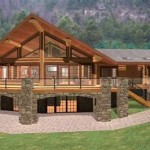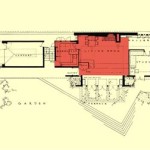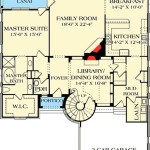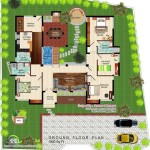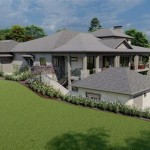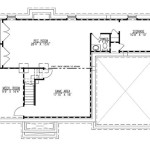Optimizing a 1000 Sq Ft House: Floor Plan Considerations
Designing a 1000 square foot house requires careful consideration of space utilization and functionality. Maximizing livability within a limited footprint necessitates strategic planning, focusing on efficient layouts and multi-purpose design elements. This article explores key aspects of floor plan design for a 1000 sq ft house, providing insights into creating a comfortable and practical dwelling.
Prioritizing Needs and Lifestyle
The initial step in designing a floor plan involves a thorough assessment of the occupants' needs and lifestyle. This entails identifying essential spaces, such as bedrooms, bathrooms, living areas, and kitchens, and determining the desired size and functionality of each. Consider the number of occupants, their daily routines, and any specific requirements, such as a home office, hobby space, or accessibility features. A young couple’s needs may differ considerably from those of a single individual or a small family.
Lifestyle considerations play a crucial role in shaping the floor plan. Individuals who frequently entertain guests may prioritize a larger living area and an open-concept kitchen. Those who work from home need a dedicated office space that is separate from the main living areas to minimize distractions. Similarly, individuals with hobbies that require dedicated space may need to incorporate a workshop or studio into the design. Defining these needs early on is essential for tailoring the floor plan to the specific requirements of the occupants.
The location of the house also impacts design choices. A house in a warm climate may prioritize outdoor living spaces, such as patios or decks, while a house in a colder climate may focus on maximizing interior space and energy efficiency. Orientation to the sun is also a key consideration, with south-facing windows maximizing natural light and passive solar heating during colder months. The surrounding environment and available views should also be considered when determining the placement of windows and outdoor spaces.
Open Concept vs. Defined Spaces
A fundamental decision in floor plan design is whether to opt for an open-concept layout or to create more defined, separate spaces. Open-concept floor plans typically combine the living room, dining room, and kitchen into a single, interconnected area. This design approach fosters a sense of spaciousness and promotes social interaction. However, it can also lead to noise and visual clutter, and may lack privacy in certain areas.
Defined spaces, on the other hand, create distinct rooms with specific functions. This approach provides greater privacy and allows for better sound control. However, it can also make the house feel smaller and more compartmentalized. The choice between open-concept and defined spaces depends on the occupants' preferences and lifestyle. A hybrid approach, which combines elements of both, can offer a balance between spaciousness and privacy.
In a 1000 sq ft house, careful consideration must be given to the tradeoffs between open and defined spaces. An open-concept living area can make the house feel larger and more inviting, but it may require careful furniture placement and organization to avoid clutter. Dividing walls create distinct spaces, but can make the house feel cramped if not implemented thoughtfully. Smart storage solutions and multi-functional furniture are essential for maximizing space efficiency in either scenario.
Maximizing Efficiency and Storage
Efficient use of space is paramount in a 1000 sq ft house. Every square foot must be carefully considered and utilized to its full potential. One strategy for maximizing efficiency is to minimize hallways and circulation areas. Hallways consume valuable space without adding functional value. By designing a layout that minimizes hallways and creates direct connections between rooms, more space can be allocated to living areas.
Storage is another critical consideration. Adequate storage is essential for keeping the house organized and clutter-free. Built-in storage solutions, such as shelving, cabinets, and drawers, can be integrated into the design to maximize storage capacity without sacrificing valuable floor space. Vertical storage, such as floor-to-ceiling bookshelves and cabinets, can also be used to take advantage of unused vertical space. Multi-functional furniture, such as beds with built-in storage drawers or ottomans that double as storage containers, can further enhance storage efficiency.
The kitchen and bathroom are two areas where efficient design is particularly important. The kitchen should be laid out to maximize workflow and minimize wasted space. A well-designed kitchen will have adequate counter space, storage, and appliance placement to facilitate efficient cooking and food preparation. The bathroom should also be designed to maximize space efficiency, with thoughtful placement of fixtures and storage solutions to minimize clutter. Wall-mounted sinks and toilets can save floor space, while recessed shelving and medicine cabinets can provide hidden storage.
Consider incorporating universal design principles, such as wider doorways and hallways, to improve accessibility and accommodate potential future needs. These principles enhance the usability of the house for people of all ages and abilities and can increase its resale value. Designing for flexibility is also important. Consider how the space can be reconfigured to meet changing needs over time. For example, a spare bedroom could be designed to function as a home office or a guest room, depending on the current needs of the occupants.
Lighting plays a crucial role in creating a comfortable and inviting atmosphere. Natural light should be maximized through the strategic placement of windows and skylights. Adequate artificial lighting is also important, especially in areas where natural light is limited. LED lighting is energy-efficient and provides a wide range of options for creating different moods and ambiance. Layered lighting, which combines ambient, task, and accent lighting, can enhance the functionality and aesthetics of the house.
Material choices also impact the overall feeling of the space. Light-colored walls and flooring can make the house feel larger and brighter, while darker colors can create a more intimate and cozy atmosphere. Durable and low-maintenance materials are ideal for high-traffic areas, such as the kitchen and bathroom. Sustainable and eco-friendly materials can also be incorporated into the design to reduce the house's environmental impact.
Ultimately, the best floor plan is one that is tailored to the specific needs and lifestyle of the occupants. By carefully considering the factors outlined above, it is possible to create a comfortable, functional, and aesthetically pleasing dwelling within a 1000 sq ft footprint. The key is to prioritize needs, maximize efficiency, and create a space that reflects the unique character of those who will call it home.
Bedrooms Configuration - Prioritizing Comfort and Functionality
Bedroom configurations in a 1000 sq ft house require careful planning to balance space efficiency with comfort. The number of bedrooms needed significantly impacts the available square footage for other essential areas. A single bedroom layout allows for a larger master suite and more spacious living areas, while a two or three-bedroom design necessitates compromises in room sizes.
In a single-bedroom scenario, the master bedroom can be prioritized with ample closet space, potentially incorporating a walk-in closet or built-in storage solutions. A dedicated en-suite bathroom is often a sought-after feature in this configuration, adding convenience and privacy. This setup is ideal for individuals or couples who prioritize a spacious and luxurious master suite.
With two or three bedrooms, strategic planning is crucial to ensure each room is functional and comfortable. Smaller bedrooms may necessitate creative storage solutions like built-in shelving or loft beds to maximize floor space. Shared bathrooms become more common in these configurations, requiring careful consideration of layout to ensure accessibility and privacy for all occupants. For smaller bedrooms, minimalist design principles are often employed, using lighter colors and simple furniture to create a sense of spaciousness.
Regardless of the number of bedrooms, proper window placement is essential for natural light and ventilation. Adequate closet space is also critical, even in smaller bedrooms. Consider incorporating adjustable shelving and closet organizers to maximize storage capacity. Sound insulation between bedrooms is an important factor, particularly in multi-bedroom layouts, to ensure privacy and minimize disturbances.

Our Top 1 000 Sq Ft House Plans Houseplans Blog Com

House Plans Under 1000 Square Feet

Three Low Budget 1000 Sq Ft Bedroom House Plans For 120 Yard 3 Cent Plots Small Hub

Traditional Plan 1 000 Square Feet 2 Bedrooms Bathrooms 348 00002

Pin Page

House Plan Choosing Between 1000 Sqft And 2000 Options Green Arch World

𝟏𝟎𝟎𝟎 𝐒𝐪 𝐅𝐭 𝐇𝐨𝐮𝐬𝐞 𝐃𝐞𝐬𝐢𝐠𝐧𝐬 With Images

Bungalow Floor Plan 2 Bedrms Baths 1000 Sq Ft 115 1371

Ranch Plan 1 000 Square Feet 3 Bedrooms Bathroom 5633 00010

7 Ideal Small House Floor Plans Under 1 000 Square Feet

